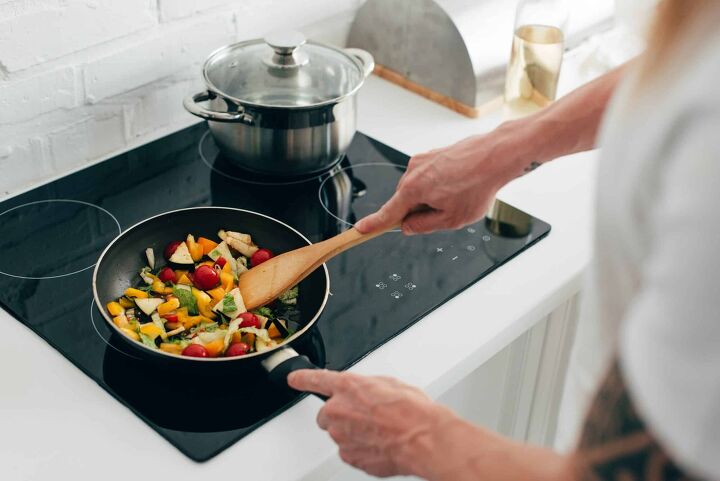What Kind Of Plug Do You Need For An Electric Stove?

Electric stoves are convenient, affordable, and less maintenance than standard stoves. However, they aren’t as easy to use right away because the power requirements can be confusing. So, what kind of plug do you need for an electric stove to work?
You need a 220-volt outlet for an electric stove because standard 110-volt outlets aren’t enough. The standard outlet in the United States is 110-volts, and you may need to install new outlets if that is all that you have. Electric stoves generally run at 50 amps, and you need a 220-volt outlet to support it.
It can be dangerous to plug an electric stove into a 110-volt outlet, and it can even trip the circuit breaker. Luckily, it is easy and affordable to install a 220-volt outlet in your kitchen. Follow along as we explore what kind of outlet is ideal for an electric oven.
Do You Need to Hire an Electrician?
Get free, zero-commitment quotes from pro contractors near you.

How to Install a 220 Volt Outlet
One of the main reasons people switch to an electric stove is because they’re incredibly powerful. Unfortunately, you can’t just plug them into any old outlet. In the United States, the most common stove outlet has just 110-volts.
If you have any doubt about your ability, knowledge, and experience to do electrical work, call a professional. When working with electrical materials, there are potential safety hazards, especially if you don’t have the proper qualifications.
Electric Stove Voltage & Wiring Requirements
Because electric stoves are more powerful, they require a constant stream of higher voltage. This helps it quickly create and maintain heat. You’ll find other appliances like dryers, and water heaters use these same methods.
Step 1
The first thing you need to do when installing a new outlet is to shut down the power source. To do this, open your circuit box and switch the main disconnect to the “off” position. It’s important to note that this will turn off the electricity to your entire home.
Once you’ve done this, check to see if it worked. You can try turning on a light to reduce the risk of electrocuting yourself when you’re working with the wiring.
Step 2
Next, you’ll have to install a new switch in the circuit box to help control the outlet for the stove. You’ll need two open slots in a single row to have enough room. This is because you’ll be installing a double-wide circuit breaker switch instead of a single.
Following the manufacturer’s guide, use the instructions to put in the new switches. Another thing you’ll need is to install a connector into the side of the circuit box. This allows you to connect the electrical cable inside of the box.
Remember, if you feel uncomfortable with the job at this or any point, stop and as a professional for help.
Step 3
The third step is to run the cable through the walls until you reach where you plan on installing the new outlet. Doing this may require drilling into the frame of your house to avoid messing with the other wiring.
Step 4
Strip away the insulation at the end of the cable and connect it to your new outlet. Then screw the outlet into the wall, and you’re nearly finished. See, it’s not that the work is hard; it’s just more dangerous than other home improvement projects.
Step 5
Last but not least, take the cable and run it through the connector that was installed in the circuit box. Ground the terminal and then wire the cable into the circuit breaker. If you feel like everything is installed correctly, turn the new switches to the “off” position.
Next, switch the main power to the house back on before turning the new switches to the “on” position. Test the outlet with a voltmeter to make sure it’s producing at least 220-volts. Then you’ll be ready to cook and bake any goodies you desire.
Electric Stove Alternatives
There are two main alternatives to electric stoves: gas and induction. They both have remarkable qualities and room for improvement. Let’s take a look at both types to give you a better idea of what suits your needs best.
Gas
There are plenty of people who love using gas stovetops. Here are some of the main reasons they prefer gas over electric.
Pros
- A gas stove heats up immediately as soon as the flame is turned on.
- Propane and natural gas are cheaper than using electricity.
- Cooking tasks, like charing vegetables, is done easier using a gas stove.
- It’s easier to control since you can visually see the flame.
- Gas stoves are more durable and can handle everyday wear and tear more.
Cons
There are a few downsides to using a gas stove that you may want to consider as well.
- They’re harder to clean due to an uneven surface.
- Because gas stoves have a higher heat output, it can raise the overall temperature in your home.
- Some homeowners won’t like the initial smell of gas.
- There’s a concern for gas leaking if the burners are left on without a flame.
- Gas stoves require specific piping, which calls for another project and more money spent.
Induction
Here are the top benefits and downfalls of using an induction stove.
Pros
- Thanks to the electromagnetic cycle, you’ll be able to cook and bake things in half the time.
- Induction stoves use less energy, which is better for the environment and will lower your electric bill.
- It’s safer for homes with children or pets because the burners cool down quickly.
- They’re incredibly easy to clean with a wet washcloth because of the all-glass top.
- Induction stoves are more modern-looking and attractive.
- They warm up incredibly quickly.
Cons
- The main downfall of an induction stove is that they tend to be expensive.
- Magnetic cookware is required if you want the induction process to work.
- If the electric power goes out, you won’t be able to use the stove.
- There’s a buzzing or humming sound when using an induction stove.
Electric Cooktop Installation Cost
I don’t know about you, but I like making a budget for my home improvement projects. This helps me stay on track and prevents me from spending too much. Below is a price guide to give you a look at how much it can cost to have an electric stove installed.
| |||||||||
Do You Need to Hire an Electrician?
Get free, zero-commitment quotes from pro contractors near you.

Related Questions
Most electrical outlets have around 15 amps of power. A stove or oven electrical outlet is required to have at least 50 amps of energy. It can have more, as long as the system isn’t able to overload.
Can I use a three-wire cord on a four-wire stove?It depends on the age of your home. A house that was built in the 1950s is considered code-compliant for a stove or dryer to be installed using a three-wire cord. Those that do have a fourth wire use it as a ground conductor.
If you’re unsure where your home stands with this, always consult a professional.
Can a gas stove be replaced with an electric?Yes, with the help of a licensed electrician. Gas stoves use around 120 volts of energy, whereas electric stoves need 220. The electrician will run a larger wire from the circuit breaker to a stronger receptacle.
There is also the requirement to cap off the gas line to prevent any leaking. If there is a gas leak, it’s important to get out of the house immediately without touching any sources of power. This isn’t a job you’d want to do by yourself without the proper knowledge.
Related Guides

Kirstin is a passionate writer who loves helping people learn new things when it comes to home improvement. When she's not behind a keyboard, she enjoys DIY projects, crafts, spending time with her pets, and making videos. She hopes that with all she writes, someone is finding a solution to their home improvement needs.
More by Kirstin Harrington










![10 Best Zero Turn Mowers – [2022 Reviews & Ultimate Buyer's Guide]](https://cdn-fastly.upgradedhome.com/media/2023/07/31/9070522/10-best-zero-turn-mowers-2022-reviews-ultimate-buyer-s-guide.jpg?size=350x220)

![10 Best Electric Lawn Mowers - [2022 Reviews & Top Rated Models]](https://cdn-fastly.upgradedhome.com/media/2023/07/31/9070486/10-best-electric-lawn-mowers-2022-reviews-top-rated-models.jpg?size=350x220)


![12 Washing Machine Brands to Avoid [with Recall Data]](https://cdn-fastly.upgradedhome.com/media/2023/07/31/9075781/12-washing-machine-brands-to-avoid-with-recall-data.jpg?size=350x220)











